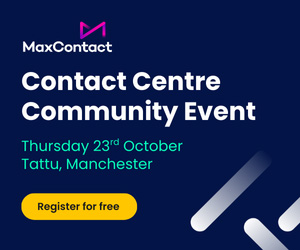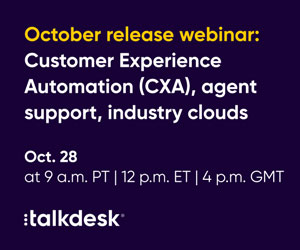Issac Thomas at Sprinklr explores the nature of bad customer service, offering insights on how to recognize it and strategies for effectively addressing and improving it.
Six in 10 Americans will walk away from a brand they actually like if it consistently delivers bad customer service – with almost two in 10 not giving it a second chance at all!
Don’t give your customers a reason to switch – at least not because of bad customer service. When it comes to customer service, your customers are smarter than ever. They know what good service is because the best companies have taught them.
Companies like Amazon, Apple, Nordstrom, The Ritz-Carlton and others that are recognized as customer service rock stars in their industries promise great service – and they deliver.
As a result, they have educated your customers on what they can expect when they deal with an excellent company.
Another thing to note is customers no longer compare you only to your direct competition. They compare you to the best service they have ever received from anyone.
That could be the aforementioned rock star companies or maybe it’s a small business they encounter in their work or in their personal lives.
If you think you only must be better than your direct competitor, you may be wrong. Sure, it’s good to be better than your competition, but the benchmark may be set by companies outside your industry. These companies have given your customers their customer service education.
In short, you don’t get to decide if your customer service is good, decent or bad. Your customer is the judge and the jury.
Nonetheless, there are ways to avoid the pitfalls that signify terrible customer service and its aftermath. Issues are hidden opportunities; you need to know how to identify them and what could be done about them.
Before we go ahead dissecting bad customer service, its impact, real-life examples and how to fix them, let’s start with the basic definition of bad customer service.
What Is Bad Customer Service?
Bad customer service is when a business or an organization fails to meet customer expectations in terms of product or service quality, response time and overall customer experience.
Poor customer service can arise for several reasons, but it’s mostly characterized by tell-tale signs like:
- Prioritizing company policies over customer needs
- Hard-to-reach agents
- Impersonal, unempathetic tone of voice
- Slow response
- Mismanaged social customer care
- Ignored customer feedback
- Disjointed support experience
- Lack of accountability
It’s like being stuck in a never-ending queue at the airport security check during a holiday rush. Well, some may say it’s an airport, combine it with a holiday, what do you expect?
Truth is, customers will expect a smooth experience, it doesn’t matter if it’s a normal day or a holiday. Failure to meet those expectations means bad customer service.
Poor customer service is often characterized by a reactive approach where issues are only addressed as they arise, leaving customers feeling neglected.
Circling back to our airport example. Communication is poor, with unclear instructions and minimal updates, the staff is unfriendly or indifferent, leaving customers stranded and dissatisfied.
Many vent out on social media and review platforms, finally drawing the airline’s attention that reacts too little, too late. This is a classic example of terrible customer service.
The airline’s brand reputation is irreversibly ruined, and it lost the goodwill and trust of loyal customers – huge costs to pay in a hypercompetitive business ecosystem where customers are spoilt for choice.
Impact of Bad Client Service
When customers are at the receiving end of bad service, their reaction can range from mild irritation to extreme public backlash, due to which companies face the following repercussions:
1. Brand Health Takes a Hit
A bad customer experience is like a spark in the forest which has the potential to set the whole forest on fire. As per a survey, 33% of customers use their social media presence to vent their anger via negative reviews and ranting tweets.
These posts become discussion points amplifying the message of how bad you are as a brand, driving away potential customers. Also, negative reviews have a long life and they stay on aggregator sites for a long time.
2. Customer Retention Becomes Difficult
Roughly six in 10 Americans will walk away from a brand they like if it consistently delivers poor customer service. This indicates that even established loyalty is fragile when service quality falters.
Remarkably, almost two in 10 won’t give the brand a second chance at all, highlighting the critical need for consistently positive interactions.
Loyalty is not a static asset. It must be continuously earned through consistent, high-quality customer service.
3. Overall Revenue Takes a Hit
Bad customer service directly leads to fewer sales as existing customers leave and potential ones avoid the brand.
Agitated customers often head straight to your direct competitors and never return (especially Boomers, per our analysis). Sometimes, competitors use social listening to home in negative reviews and jump in at opportune times to poach your customers/leads.
Consequently, revenue and market share suffer. Decreased revenue impacts overall profitability, undermining financial stability and growth prospects.
4. Low Lead Conversion
When your brand reputation takes a hit, people who were previously interested in your products or services will shy away from signing on the dotted line, eroding your lead generation efforts.
5. Operational Costs Go Overboard
Poor customer service drives up operational costs due to increased time spent handling complaints, processing refunds and managing escalations.
Repeated issues require additional resources to resolve, leading to higher staff turnover and training expenses.
Bad Customer Service vs. Good Customer Service
The repercussions of bad customer service are horrifying, aren’t they? To avoid them, one of the basics you need to know is the difference between good customer service and bad customer service.
| Aspect | Bad Customer Service | Good Customer Service |
|---|---|---|
| Response Time | Slow responses; long wait times | Quick responses; minimal wait times |
| Communication | Poor, unclear, or inconsistent communication | Clear, concise and consistent communication |
| Attitude | Unfriendly, rude, or indifferent | Friendly, courteous and empathetic |
| Problem Resolution | Issues remain unresolved; no follow-up | Effective resolution; thorough follow-up |
| Knowledge | Lack of product/service knowledge | Well-informed; able to provide accurate information |
| Personalization | Generic responses; no effort to personalize | Personalized interactions based on customer history and preferences |
| Proactivity | Reactive; only responds when a problem arises | Proactive; anticipates and addresses issues before they escalate |
Three Real-Life Examples of Poor Customer Service
Poor customer service can turn a simple interaction into a frustrating ordeal, leaving customers feeling undervalued and disrespected.
Here, we explore real-life examples of customer service blunders, shedding light on how these mistakes can seriously impact a brand’s reputation and customer loyalty.
1. When Insurance Guarantees Fail, Trust Erodes
Andrew Karaman shared his story of bad customer service on Quora, recounting how he shipped a few radiation detectors from the UPS store.
Because the instruments were fragile and expensive, he insured the shipment for $10,000, costing him over a hundred dollars.
Three days later, Andrew received an email from UPS staff informing him that the package had been damaged and the detector had broken, with attached photos as evidence. It took a few months for the damage to be fixed and cost him $360.
Expecting a refund due to the insurance, Andrew visited the UPS website to find information on filing an insurance claim but found nothing.
Seeking answers, he went to the local UPS store, where staff directed him to contact UPS Customer Service. With no live chat available on the website, Andrew sent an email describing the incident.
This began a frustrating month-long process, with UPS repeatedly asking for more information and photos.
Exhausted from waiting, Andrew eventually called customer support. The situation worsened as he was bounced from one representative to another, re-explaining his story multiple times.
Finally, he reached someone who refused to honor the insurance claim, with no alternatives or opportunities to appeal.
Frustrated and disappointed, Andrew vowed never to ship with UPS again, a sentiment reflecting the severe impact of poor customer service on customer loyalty.
Consequence: This negative experience cost UPS not only a loyal customer but many more potential ones. The brand lost consumer trust and brand reputation when the incident came to light.
2. When Online and Offline Contradict Each Other
A major telecom provider promotes a special unlimited data plan on its website, but when customers visit its store and call customer support, they receive contradictory information about data limits and pricing. The store clerk insists the plan includes a data cap, while customer service on the phone confirms it does not.
Consequences: Customers are confused and frustrated by the conflicting details, which leads to higher-than-usual plan cancellations and disputes. The telecom provider faces increased customer churn and dented credibility.
3. Avoid Bureaucratic Processes When Resolving Customer Issues
A customer at a national bank encounters a minor error in their statement and needs it corrected. To address the issue, they must navigate through an automated phone system, submit a written request and visit a branch, each step involving long waits and repeated explanations of the issue.
Consequences: The lengthy and cumbersome process frustrates the customer, leading to a loss of trust in the bank’s efficiency and a decline in overall customer satisfaction.
Common Reasons for Bad Customer Service and Their Fixes
To err is human, to correct it is divine! Now that you understand what bad customer service is, let’s delve further and learn how to fix common customer service failures.
1. Prioritizing Company Policies Over Customer Needs
Rigid, company-centric policies can hinder personalization of the support experience and turn it into an impersonal affair. As a result, customers might end up feeling like a mere number, not a valued person.
It in turn dwindles their emotional investment in your company and offerings. They will easily move to any competitor who offers them service with a human touch.
How to Fix It?
Build flexible support policies prioritizing customer satisfaction over success metrics. Adapt your policies for reasonable customer needs and build a customer-centric culture that percolates top-down in your organization.
2. Hard-to-Reach Agents
Customers often struggle to reach support agents due to factors such as limited availability, inefficient routing systems, long wait times and inadequate staffing. This can lead to increased frustration, dissatisfaction and a negative perception of the company.
How to Fix It?
Offer support through different customer service channels such as phone, email, chat and social media to accommodate different customer preferences.
Ensure adequate staffing during peak hours to handle high volumes of inquiries and leverage skill-based routing to direct customers to the most appropriate agent or department.
3. Impersonal, Unempathetic Tone of Voice
An impersonal and unempathetic tone can occur due to lack of proper training, high-stress environments or agents being focused more on resolving tickets quickly rather than understanding customer concerns.
How to Fix It?
Conduct regular training on empathetic communication and active listening to ensure agents understand the importance of a personal touch.
Review and provide feedback on agent interactions. It ensures your agents align with customer empathy and personalization standards.
Provide a supportive work environment to reduce stress and improve agent well-being, enabling them to engage more positively with customers.
4. Slow Response
Slow responses can be caused by high inquiry volumes, inefficient processes, lack of prioritization and insufficient use of automation. This can frustrate customers and create a perception of inefficiency and neglect.
How to Fix It?
Define and communicate service level agreements (SLAs) for response times and adhere to them to set customer expectations.
Implement chatbots and automated responses to handle routine queries quickly and efficiently. Use a priority system to address urgent and high-impact issues more quickly.
5. Mismanaged Social Customer Care
Mismanaged social customer care can result from inconsistent monitoring, lack of dedicated resources and unclear protocols for handling social media interactions.
How to Fix It?
Use a unified platform to monitor and respond to social media inquiries from one place, ensuring consistency. Establish clear protocols and guidelines for social media interactions to ensure timely and appropriate responses.
6. Ignored Customer Feedback
Customer feedback is often ignored due to a lack of a structured feedback management process, insufficient analysis or failure to act on insights.
How to Fix It?
Use customer surveys, behavior analytics and direct communication to gather customer opinions systematically. Leverage customer feedback management techniques to analyze feedback.
Implement changes based on customer suggestions and insights. Follow up with customers who provided feedback to let them know how their input has been used.
7. Disjointed Support Experience
A fragmented support experience can occur due to siloed systems, inconsistent information and lack of integration across support channels.
How to Fix It?
Use a centralized customer support platform to provide a seamless experience across all channels and touchpoints. Develop standardized processes and a comprehensive knowledge base to ensure consistent information and service.
Frequently Asked Questions
What Are Some Common Signs of Bad Customer Service in a Company?
Common signs of bad customer service include long wait times, rude or unhelpful staff, lack of follow-up, inconsistent information, unresolved issues, difficulty reaching support and a general lack of empathy or understanding of customer needs.
What Are the Legal Implications of Bad Customer Service?
Bad customer service can lead to legal implications such as breaches of consumer protection laws, fines, lawsuits for negligence or misrepresentation and violations of privacy regulations, all of which can damage a company’s reputation and financial standing.
How Do Customers Typically React to Bad Customer Service?
Customers typically react to bad customer service with frustration, dissatisfaction and complaints. They may leave negative reviews, seek alternatives, or escalate the issue, which can damage the company’s reputation and lead to a loss of loyalty and revenue.
Are There Any Industries More Prone to Bad Customer Service, and Why?
Industries like telecommunications, airlines, and retail are more prone to bad customer service due to high customer expectations, complex services and frequent issues. Inadequate training, understaffing and outdated systems often exacerbate these problems.
What Steps Can Be Taken to Recover From Bad Customer Service Incidents?
To recover from bad customer service incidents, promptly apologize, offer a solution and provide compensation if necessary.
Ensure follow-up, improve processes and train staff to prevent recurrence, showing genuine commitment to customer satisfaction.
Author: Sprinklr
Published On: 20th Aug 2024 - Last modified: 22nd Oct 2024
Read more about - Guest Blogs, Sprinklr





































